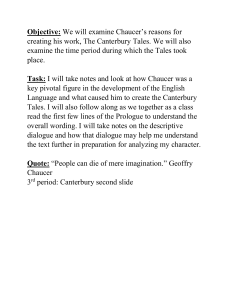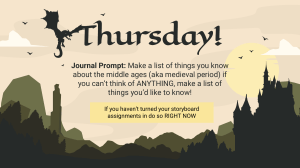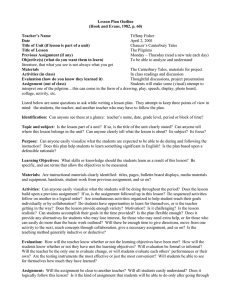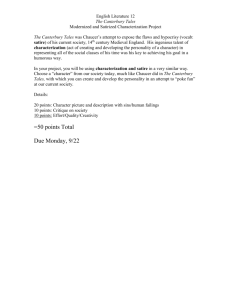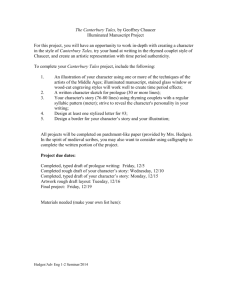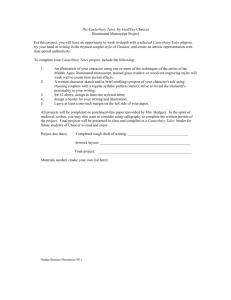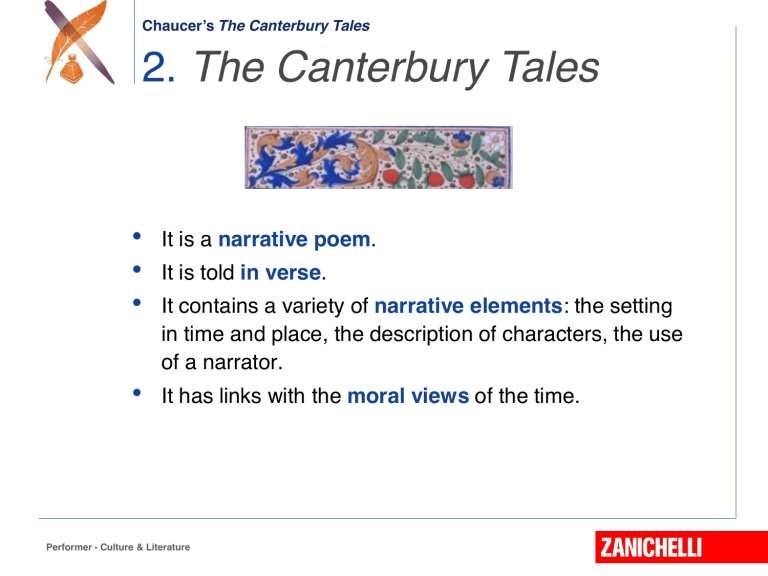
Chaucer’s The Canterbury Tales 2. The Canterbury Tales • • • It is a narrative poem. • It has links with the moral views of the time. It is told in verse. It contains a variety of narrative elements: the setting in time and place, the description of characters, the use of a narrator. Performer - Culture & Literature Chaucer’s The Canterbury Tales 3. The story • Thirty people, including Chaucer as narrator, meet at the Tabard inn in London. • They join a pilgrimage to Canterbury Cathedral and the shrine of Thomas Becket. • The innkeeper suggests that every pilgrim should tell two stories on the way to Canterbury and two on the way back; the pilgrim who tells the best story will win a free dinner. • The various tales are both religious and humorous, moral and satirical. Performer - Culture & Literature Chaucer’s The Canterbury Tales 4. The pilgrimage • Why a pilgrimage to Canterbury? - Canterbury Cathedral is the shrine of Thomas Beckett, England’s first martyr. - Taking a pilgrimage was common in Chaucer’s day. - People went on a pilgrimage to ask for healing or forgiveness of sins but also to socialise. Performer - Culture & Literature Chaucer’s The Canterbury Tales 5. Social satire It is an estates satire (a social satire) stock characters (stereotypes) are presented, but they are also individuals (with their own personality, lifestyle, experiences) from the three orders of society (the nobles, the clergy and the peasants) and from the rising middle class. Performer - Culture & Literature Chaucer’s The Canterbury Tales 6. The structure: the “pilgrimage” is the frame that contains all the stories. The idea is similar to Boccaccio’s “Decameron”. A general prologue, where the pilgrims are introduced Twenty-four tales usually preceded by a prologue, which introduces the theme of the tale and sometimes followed by an epilogue Performer - Culture & Literature Chaucer’s The Canterbury Tales 7. The language During the Middle Ages three languages were spoken in England: French (spoken by the Norman aristocracy), Anglo-Saxon (spoken by the natives) and Latin (spoken by the Church). By the time Chaucer wrote The Canterbury Tales: • English had replaced French as the language of education in the local schools. English was becoming the language of government. There was a growing demand for literary works in English. Chaucer created a literary language shaped by French and Latin models but built upon the old popular tradition and on a deep knowledge of actual speech. He is considered the “father of English poetry”. Performer - Culture & Literature Chaucer’s The Canterbury Tales 8. Characterisation • Chaucer wanted to give a portrait of English society. • He introduced the characters in the General Prologue. • He did not follow the social hierarchy of presentation of the time. • He mixed female and male characters to underline the growing importance women were assuming within the middle classes. Performer - Culture & Literature Chaucer’s The Canterbury Tales 8. Characterisation • The descriptions of the pilgrims emphasise: - clothes; - tools; - personal qualities; - personality. • The names given to the pilgrims refer to their professions. Performer - Culture & Literature Chaucer’s The Canterbury Tales Some important characters in the “Prologue”: • A knight: with his son he is the only representative of the noble class. He has fought in many military campaigns, he represents the warlike aspect of nobility. •A prioress, a member of the clergy. Chaucer’s description doesn’t highlight her faith but her elegant and refined manners in society, making fun of her. • The wife of Bath: she doesn’t belong to any of the traditional medieval orders of society. She’s a member of the rising middle class: she’s a merchant and a woman. In describing her Chaucer uses a lot of irony. Performer - Culture & Literature Chaucer’s The Canterbury Tales The Wife of Bath • It's written in rhyming couplets of iambic pentametres (= each line has ten syllables). • The title tells us the social condition of this woman (she's a “wife”, actually a widow) and where she is from (Bath). • Chaucer describes various details of the Wife of Bath: Her economic skills (cloth-making) and social skills (she's very sociable and likes talking). Her clothes (very refined) Her social status (rich and with a high reputation) Her physical appearance Her personality (passionate) • • • • • Performer - Culture & Literature Chaucer’s The Canterbury Tales Chaucer uses irony in his description: • Some features of the character are exaggerated (many husbands, many pilgrimages, she dresses smartly...) • She seems to be more interested in the social aspect of pilgrimage rather than in its religious aspect. • The wife of Bath is both a stereotype (the rich lady) and an individual. • She doesn't belong to any of the three orders of medieval society but she's a member of the new middle class. Performer - Culture & Literature


